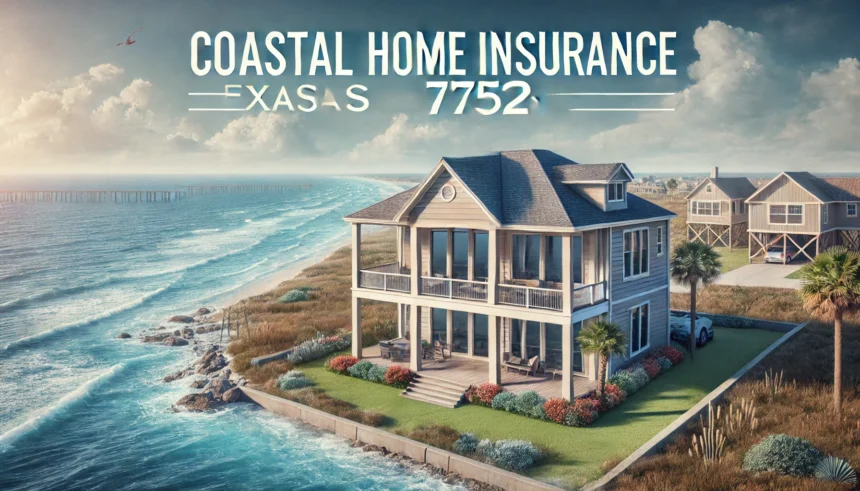If you’re a Coastal Home Insurance Texas 77523, located near the Gulf of Mexico, your home faces unique risks that require special insurance coverage. Coastal areas like this are prone to hurricanes, flooding, and windstorms, making it crucial to have the right type of home insurance. Unfortunately, a standard home insurance policy is usually insufficient for these areas, as it doesn’t cover certain disasters, such as windstorms, hail, or flood damage. To ensure that your home is fully protected, you need to understand coastal home insurance and the types of coverage necessary.
This article explores the importance of coastal home insurance in 77523, the types of coverage needed, how to reduce costs, and how to find the right insurance policy. By the end of this guide, you’ll be well-equipped to protect your home from the unique risks associated with coastal living.
What is Coastal Home Insurance?
Coastal home insurance refers to homeowners policies specifically designed to protect homes located in areas at high risk of natural disasters, such as hurricanes, windstorms, and flooding. In areas like Baytown (77523), the risks are higher due to the proximity to the Gulf of Mexico, which makes it vital for homeowners to ensure their property is covered adequately.
Unlike standard home insurance, which typically covers fire, theft, and vandalism, coastal home insurance focuses on additional risks such as:
- Windstorm Damage: Strong winds from hurricanes can tear off roofs, break windows, and cause extensive damage.
- Flooding: Coastal areas are more prone to flooding, especially from storm surges during hurricanes or heavy rainfalls.
- Hailstorms: Coastal regions can experience severe hailstorms that damage roofs, windows, and other structures.
Why is Coastal Home Insurance Crucial?
Living close to the coast increases your exposure to weather-related risks, and these risks are not typically covered under standard homeowners insurance. Without the right policy, you could be left financially vulnerable after a disaster.
Standard Home Insurance vs. Coastal Coverage
While standard home insurance typically covers basic damages like fire, theft, and vandalism, it does not cover:
- Windstorm Damage: This includes damage caused by hurricanes or strong winds.
- Flooding: Standard policies exclude flood coverage, which is crucial in coastal areas.
- Hail and Storm Damage: In coastal areas, hailstorms are common, and their impact can be severe on homes.
Because of these exclusions, it’s essential for homeowners in 77523 to secure additional coverage to ensure their homes are fully protected.
Essential Insurance Policies for Coastal Homes
Windstorm and Hail Insurance
Windstorm damage is one of the most common and most costly types of damage for homeowners in coastal Texas. Unfortunately, most standard homeowners insurance policies exclude windstorm damage.
To protect against windstorms, homeowners in 77523 often need to secure windstorm insurance through the Texas Windstorm Insurance Association (TWIA). This state-run association offers coverage for properties located in high-risk coastal areas.
For hail damage, homeowners may need specific hail insurance depending on the region. These types of policies cover repairs from hailstorms, which are also a significant risk along the Texas coastline.
Flood Insurance
Flooding is another major concern for coastal homeowners. Standard home insurance policies do not cover flood damage. Due to the high flood risk in many areas like 77523, homeowners need to purchase flood insurance.
Flood insurance is available through the National Flood Insurance Program (NFIP), which is backed by the federal government. Some private insurers may also offer flood coverage, but it’s essential to know that flood insurance is a separate policy from standard home insurance.
Even if you don’t live in a high-risk flood zone, it’s still wise to consider flood insurance, as heavy rains or hurricanes can cause flooding, and these floods can be highly damaging to your home.
Additional Coverage Options
In addition to windstorm and flood coverage, there are other policies that homeowners in coastal areas should consider:
- Hurricane Insurance: Some insurers may offer hurricane insurance that covers damages caused by hurricanes, which often include windstorm and flooding.
- Sewer Backup Insurance: Coastal storms can lead to sewer backups, which are not covered under standard flood policies but may be included in separate sewer backup insurance.
- Extended Replacement Cost Coverage: This policy can cover the costs of rebuilding your home after a disaster, especially considering the rising cost of materials following major storms.
Factors Affecting Insurance Costs in 77523
Location & Flood Zones
One of the biggest factors that affect your insurance premiums is whether or not your home is located in a flood zone. Homes in flood-prone areas face higher insurance costs due to the increased likelihood of flooding.
To reduce these costs, homeowners can obtain an elevation certificate, which verifies the height of their property above the base flood elevation. Homes located above flood levels may qualify for lower premiums.
Construction Materials & Home Design
Homes built with storm-resistant materials, such as reinforced roofing and hurricane-proof windows, are more likely to qualify for lower insurance premiums. The design of your home (such as its roof pitch, building materials, and whether it has impact-resistant windows) also plays a role in determining your premium.
Homes that are built to withstand hurricanes or strong winds will be considered less risky to insure, and as a result, insurance companies may offer discounts.
Deductibles & Policy Limits
In coastal regions, it’s common for homeowners to face higher deductibles for certain types of claims, particularly those involving windstorm or hurricane damage. A higher deductible can lower your monthly premium, but it also means you’ll pay more out of pocket if a disaster strikes.
Policy limits are also essential to review. Make sure the policy covers the full rebuilding cost of your home, as construction costs may rise after a major disaster.
- Discounts & Savings Tips
- Hardening your home: Install storm shutters, impact-resistant windows, and reinforce your roof to lower premiums.
- Bundling insurance: Consider bundling home and auto insurance policies with the same provider to get a discount.
- Maintaining a good claims history: Insurers reward customers with fewer claims by offering them lower rates.
How to Find the Right Insurance Provider
Finding the right insurance provider for your coastal home requires some research. Some key points to consider when selecting an insurer include:
Choose an Experienced Agent
Work with an insurance agent who specializes in coastal properties. These agents will be more familiar with the risks and coverage options for homes in areas like 77523.
Compare Insurance Quotes
Get quotes from multiple insurance providers to compare coverage options and prices. Be sure to evaluate the coverage limits, exclusions, and deductibles for each quote.
Understand Policy Terms
Carefully read the terms of the policy to understand what is covered and excluded. Pay close attention to hurricane or windstorm coverage, as well as any special exclusions or endorsements.
Steps to Get Coastal Home Insurance in 77523
- Assess Your Risks: Determine if your home is in a flood zone or prone to windstorm damage.
- Determine Coverage Needs: Decide whether you need flood insurance, windstorm coverage, or additional protection.
- Get Inspections: Some insurers require home inspections before they will offer coverage.
- Get Multiple Quotes: Contact several insurance companies to compare coverage and premiums.
- Review and Finalize Your Policy: Make sure you understand your coverage, limits, and deductibles before signing.
Conclusion
Owning a Coastal Home Insurance Texas 77523 means facing unique challenges when it comes to insurance. A standard homeowners policy won’t be enough to fully protect you from the storm, wind, and flood risks common in coastal areas. By obtaining windstorm, flood, and additional coverage, you can ensure that your home is adequately protected.
Be proactive by assessing your risks, comparing quotes, and finding the best coverage options that meet your needs. With the right insurance in place, you can have peace of mind, knowing that your home is protected from whatever nature throws your way.
FAQs
Do I need flood insurance if I don’t live in a high-risk flood zone?
Yes, even low-risk areas can experience flooding from heavy storms or drainage issues, and standard home insurance does not cover flood damage.
Can I get windstorm insurance from my regular home insurance provider?
Not always—many insurers in coastal Texas exclude windstorm coverage, but you can get it through the Texas Windstorm Insurance Association (TWIA).
What is an elevation certificate, and how does it help?
An elevation certificate proves your home’s height relative to flood levels, and it can help lower your flood insurance costs if your home is above the risk zone.
Are hurricane deductibles different from regular home insurance deductibles?
Yes, hurricane deductibles are often higher and calculated as a percentage of your home’s insured value, rather than a fixed dollar amount.
Does home insurance cover damage from storm surges?
No, storm surge damage is considered flooding and is only covered by a separate flood insurance policy, not standard homeowners insurance.









